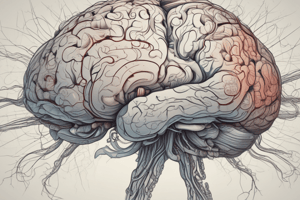Podcast
Questions and Answers
What is the primary function of proteins within the cell membrane?
What is the primary function of proteins within the cell membrane?
- Store genetic information
- Serve as ion channels and receptor molecules (correct)
- Provide structure to the lipid bilayer
- Control the fluidity of the membrane
What characteristic of the cell membrane allows it to control the movement of substances in and out of the cell?
What characteristic of the cell membrane allows it to control the movement of substances in and out of the cell?
- Impermeability to all substances
- Selective permeability (correct)
- High concentration of ribosomes
- Multiple layers of protein molecules
Which ion is the cell membrane permeable to during resting conditions?
Which ion is the cell membrane permeable to during resting conditions?
- Sodium (Na-)
- Calcium (Ca2+)
- Potassium (K+) (correct)
- Chloride (Cl-)
Which electrical state of the neuron is associated with an inactive neuron?
Which electrical state of the neuron is associated with an inactive neuron?
What functional role do the proteins in the cell membrane NOT serve?
What functional role do the proteins in the cell membrane NOT serve?
What process is responsible for the propagation of signals along axons in neurons?
What process is responsible for the propagation of signals along axons in neurons?
Where are local, or graded, potentials initiated in a neuron?
Where are local, or graded, potentials initiated in a neuron?
What happens to local or graded potentials as they are transmitted?
What happens to local or graded potentials as they are transmitted?
What is the measured voltage of the resting membrane potential in an inactive neuron?
What is the measured voltage of the resting membrane potential in an inactive neuron?
What makes the cell membrane selectively permeable during resting conditions?
What makes the cell membrane selectively permeable during resting conditions?
Flashcards are hidden until you start studying
Study Notes
Introduction to Neuroscience
- Neuroscience is the study of the nervous system, which consists of the brain, spinal cord, and nerve cells.
- The nervous system is composed of two main types of cells: neurons and glia.
- Neurons are specialized for communication, while glia provide support for neurons.
- The human brain contains approximately 80-100 billion neurons.
Neuron Structure
- The three main parts of a neuron are the dendrites, cell body, and axon.
- Dendrites receive chemical messages from other neurons.
- The cell body contains the nucleus and other structures, wrapped by a selectively permeable membrane.
- The axon is a long, slender process that carries information from the cell body to the terminal buttons.
- Terminal buttons contain synaptic vesicles that release neurotransmitters into the synapse.
Types of Neurons
- Motor neurons conduct messages from the brain and spinal cord to muscles and organs.
- Sensory neurons carry information from the body and world to the brain and spinal cord.
- Interneurons conduct information between neurons in the same area.
Neuron Function
- Neurons transmit information through electrical and chemical signals.
- Spatial summation combines potentials occurring simultaneously at different locations on the dendrites and cell body.
- Temporal summation combines potentials arriving a short time apart, from either the same or separate neurons.
Synaptic Activity
- When an action potential reaches the terminal button, neurotransmitters are released into the synapse.
- Neurotransmitters bind to receptors on the postsynaptic neuron, causing a change in the electrical properties of the neuron.
- Reuptake is the process by which neurotransmitters are taken back into the terminal buttons by membrane proteins (transporters).
Excitation and Inhibition
- Excitation is the process by which a neuron is made more likely to fire an action potential.
- Inhibition is the process by which a neuron is made less likely to fire an action potential.
- Both excitation and inhibition are equally important for proper neural function.
Resting Potential
- The resting potential is the electrical state of a neuron at rest, with a negative charge on the inside compared to the outside (-70mV).
- The resting potential arises from a combination of electrostatic forces, ion concentration gradients, and selective permeability.
- Sodium-potassium pumps help maintain the electrical gradient.
Action Potential
- An action potential is a brief electrical impulse that travels along an axon and allows one neuron to communicate with another.
- The action potential is possible due to the semi-permeable membrane, which maintains chemical and electrical gradients across the membrane.
- Depolarization changes the voltage, which may cause voltage-sensitive ion channels to open and allow ionic diffusion.
- The action potential is an all-or-none event.
Glia
- Glia are the other major component of the nervous system, providing support for neurons.
- Astrocytes help synchronize the activity of the axon by wrapping around the presynaptic terminal and taking up chemicals released by the axon.
- Microglia remove waste material and other microorganisms that could prove harmful to the neuron.
- Oligodendrocytes and Schwann cells build the myelin sheath that surrounds the axon of some neurons.
- Radial glia guide the migration of neurons and the growth of their axons and dendrites during embryonic development.
Neurotransmitters
- Neurotransmitters are chemical substances released synaptically from one neuron that affect another cell in a specific manner.
- There are three general categories of neurotransmitters: amino acids, amino acid-derived, and peptides.
- Examples of neurotransmitters include GABA, dopamine, norepinephrine, serotonin, and peptides.
Cell Membrane
- The cell membrane is formed from two layers of lipid molecules with proteins "floating" within the bilayer.
- The cell membrane is selectively permeable, allowing certain molecules to pass through while keeping others out.
Studying That Suits You
Use AI to generate personalized quizzes and flashcards to suit your learning preferences.




